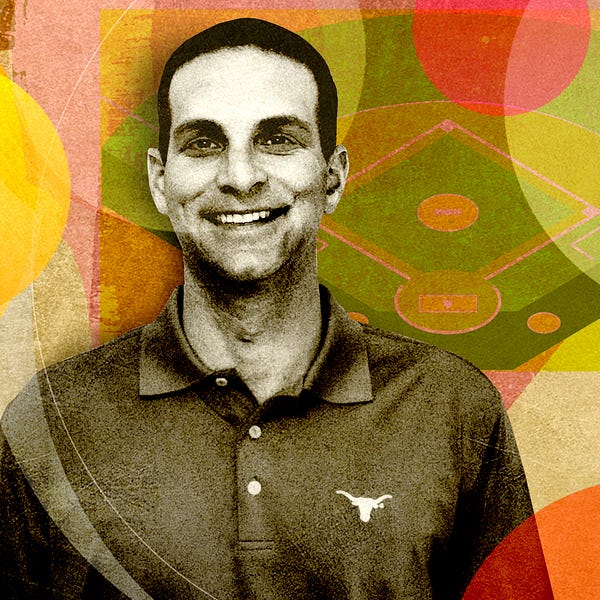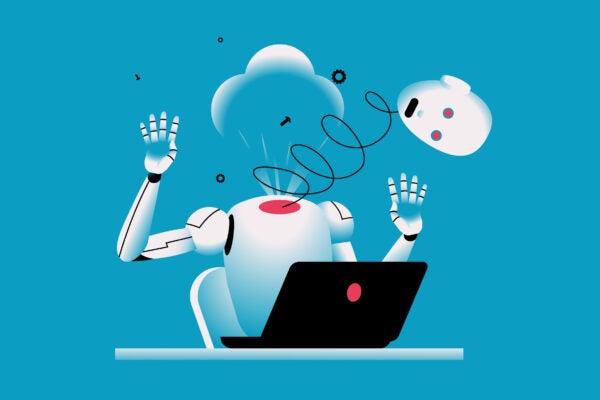Multitasking on the Job
Employees who like to juggle projects have advantages in the workplace

By Steve Brooks
Lisa Simon, MBA ’14, treasures the occasional day when she can stay
at home and work on a single project. But her office is never far
from her mind or her inbox.
“While I may be focused on one task, I closely monitor the emails coming in,” says the manager at Deloitte Consulting in Dallas. “There might be something urgent from a client.”
She’s accustomed to performing several jobs at once, otherwise known as multitasking. In the words of Janet Dukerich, management professor at the McCombs School of Business, Simon is being polychronic. In new research, Dukerich finds a variety of benefits to being polychronic, especially in the beehive of the modern-day workplace. It’s not just being able get a lot done. It positions a person at the center of office social networks.
“Being central to a network has advantages, because you’re often privy to information before others,” she says. “Information is power in most organizations.”
It can also help to move more quickly up the career ladder. “You’re often seen as a key player, as one of the go-to people,” she says.
Invigorating—or Annoying
Dukerich came to the subject through personal experience. Besides teaching,
she recently served as senior vice provost for faculty affairs at The University of Texas at Austin. To see that faculty policies were applied fairly across campus, she dealt with people at 19 different colleges and schools.


“Multitasking is something I am used to doing on a daily basis,” she says. “I
like to move around from task to task.” But even while she enjoyed the constant juggling her executive position required, its demands kept her from having as much time as she would have liked to focus on research. Now that she’s taken on a different role in the provost’s office — vice provost for advocacy and dispute resolution — her administrative responsibilities will only take 50 percent of the time they did previously. She says she’s looking forward to the opportunity to getting back to her research.
That puts her, she says, in the middle ground between polychronic and its
opposite: monochronic. “People high in polychronicity like to have many tasks going on simultaneously,” Dukerich says. “They can shift from one task to another very easily. They actually prefer that. Monochronic people find that very annoying. They like to start one task, finish it and pick up another.”
On a deeper level, Dukerich adds, they have clashing views of time. Polychronic people see it as cyclical, with several cycles happening at once. Monochronic people see it as linear, a sequence of one event after another.
Her mixed feelings got her wondering how other people felt about juggling
multiple jobs, and how it might affect their status at the office.
To find out, Dukerich collaborated with faculty colleagues Fabiola Bertolotti and Elisa Mattarelli, both of the University of Modena and Reggio Emilia, Italy.
They contacted an Italian business that was a fertile ground for multitasking. It worked on alternative fuels for motor vehicles, in a country where 1.3 million of them run on natural gas. That meant a host of research and development teams, with workers overlapping among them.
The researchers asked 71 employees to fill out a questionnaire. Participants scored their own preferences — for or against multitasking — on a scale from 1 to 7, with 7 the most favorable. Using the same scale, they rated how strongly
the firm expected them to juggle jobs.
The results showed that the employees leaned slightly toward multitasking. But the company’s expectations were even stronger. On average, participants scored their own affinities at 4.0 and the company’s at 4.6.
The employees were also well connected. The average worker served on five teams and communicated with 23 colleagues.
But those who rated themselves high on multitasking turned out to be the most connected. They communicated more with co-workers. A worker whose taste for multitasking was 1.25 points higher than average was 55 percent more likely to be someone whom colleagues sought out for advice.
“People who are highly polychronic like it when people come to them for advice,” Dukerich says. “They enjoy being interrupted, as opposed to people who shut the door and say, ‘Please do not disturb me until I get my work done.’”
One Task or Many?
Neither orientation is right or wrong, according to Dukerich. What’s important is that managers don’t assign multiple projects without taking
the person into account.
“Individuals will flourish better if they’re paired with compatible projects,” she says. “Some projects require lots of interaction, in an open office space where people are frequently bombarded with interruptions. For some individuals,
that’s acceptable and desirable.
“For others, having a space where they can shut the door is preferable, at least part of the time. If they’re being overwhelmed by interacting with people on a continuous basis, they may not be as effective in terms of performance.”


Job seekers, too, should compare their appetites for multitasking with the demands of the company. “Organizations have different cultures,” Dukerich says. “You should look for a congruence between your personal preferences
and the expectations of the organization.”
If a worker wants to move ahead more quickly, she adds, they should seek opportunities to join more teams.
“If you want your name out there, one way to do it is to multitask,” says Janet Dukerich, professor of management. “As a colleague of mine says, ‘it’s not who you know, it’s who knows you.’”
A Polychronic Personality
In today’s frenetic workplaces, several recent McCombs alumni say that Dukerich’s findings reflect their own experiences.
Kevin Zlotnik, MBA ’15, fits the polychronic profile. “I’m lucky to be able to multitask,” he says. “I’d get bored if I had to show up for work and do the same thing over and over.”
His family business, BZMZ Interests of Houston, gives him ample opportunity. As vice president of development, he ping-pongs between overseeing a minor-league baseball team and underwriting investments in other companies.
Supervising the baseball team, with scores of employees and thousands of customers, gives him a feeling of connection. “You have to get out of the
executive office and talk to everybody, or you don’t know what’s going on,” he says. “Otherwise, people don’t feel comfortable knocking on your door.”
Zlotnik is so used to interruptions that he gets nervous when he has none. Recently, he recounts, “I was on an airplane, and I had to be off the laptop for an hour. I felt anxious.”
Giving Your Best 85 Percent
Simon, the manager at Deloitte, is closer to the middle of the spectrum. Her job requires her to be polychronic, involved with up to eight projects and teams at any given time.
“We live in a world where you almost can’t focus too hard, because things happen so fast around you,” she says. “You have to have the flexibility to
quickly shift your focus where it’s needed.”
Simon has devised her own systems for making it easier. One is to have her teams collaborate, using online applications like Microsoft OneNote or Google Docs. “For the few seconds that I have to pay attention to that project, I know where to go to get the latest and greatest information,” she says. “It helps my mind switch gears more quickly.”
When she wants to minimize interruptions, she works from home. The rest of the time, though, she enjoys being in the nerve center of activity.
“You’re the one who’s responsive, resourceful, and willing to share with others on a timely basis,” Simon says. “Because of that, more people are interested in working with you.”
But she adds, “I sometimes wish my job required less multitasking. I want to give everything I’m responsible for 100 percent of my attention, but often I have to settle for 75 to 85 percent of my attention.”
Learned Flexibility
Multitasking hasn’t come naturally to Ashley Loney, BBA ’06. But as managing director of resources at Accenture in Austin, she’s discovered that it can be learned.
“I’m an introvert in my core,” she says. “But as I’ve progressed in my job, I’ve learned to focus on 10 different things at a time with 10 different groups of people. Now, I feel like I thrive in a flexible environment.”
One thing that’s helped is taking concise notes. “I don’t recall levels of details,” Loney says. “If I have to switch between 10 different projects, I can look at two or three bullet points, and it brings everything back to me.”
Over time, that networking has helped her get ahead faster. “The more teams you’re on, the more exposure you have to leadership,” she says. “If you’re only involved in one project, people start to ask, ‘Are you really making the impact
you could?’”
When Loney comes back to McCombs to recruit talent, she looks not just for good grades but for multitasking skills.
“Out of the gate, at Accenture, you’re going to be juggling a couple of projects,” she says. “So we look for people who have had multiple things going on at once. We value someone who works while they’re going to school, because the ability to balance priorities is very important.”
As Loney has become more polychronic, it’s even bled into her personal life. “I cook a lot, and my goal is to have everything finished at the same time,” she says. “I multitask 10 different things, and I make sure that it all comes together at the end.”
About this Post
Share:


